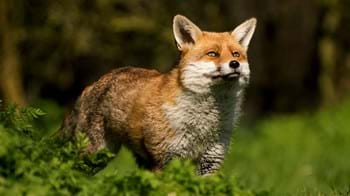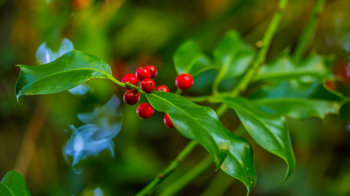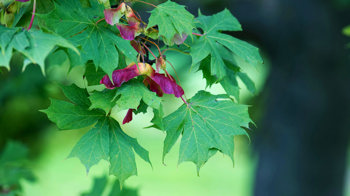
Coed Felenrhyd & Llennyrch
Maentwrog

Woodland Trust wood group
- Coed Felenrhyd
- Llennyrch
89.61 ha (221.43 acres)
SH656389
Explorer 18
OS Landranger 124
Coed Felenrhyd & Llennyrch is a rare, Atlantic oak woodland and one of our largest woods in Wales. It sits above the Vale of Ffestiniog and is fringed by the dramatic waterfalls of the Afon Prysor gorge in the Snowdonia National Park.
Explore its atmospheric pools and take in dramatic views of Snowdon to the north and the rugged uplands of the Rhinog mountains to the south.
Features
- Parking nearby
- Public access
- Autumn colour
- Waymarked walk
How to get to Coed Felenrhyd & Llennyrch
Coed Felenrhyd & Llennyrch covers 310-hectares (765-acres) in the Snowdonia National Park, and stretches from Llyn Trawsfynydd in the east and almost to the meeting of the Prysor and tidal Dwyryd rivers in the west.
From Maentwrog, take the A496 road to Harlech. After you pass the Maentwrog power station entrance on your left, look for the main woodland entrance on the same side of the road just after crossing a bridge. Alternatively, approach Llennyrch from the dam at Trawsfynydd.
The nearest train station is Llandecwyn, which is a 3km (2-mile) walk from the wood, along the Wales Coast Path.
Visit National Rail for more information.
The nearest bus stop is at the power station, not far from the wood, with services to Blaenau Ffestiniog and Bangor via Oakeley Arms.
Visit Traveline for more information.
Facilities and access
Coed Felenrhyd & Llennyrch has informal public access through two public rights of way and many permissive paths.
A network of paths and tracks cross the site and include a waymarked trail and other interpretation material which was installed as part of the Gwefr y Coed/Wild About Woods project in 2000.
The main entrance is at the lower end of the woodland where a double gate is located. From here, a footpath loop follows the valley of the Ceunant Llennyrch, starting fairly wide and level but becoming steeper as it rises towards the waterfall at the eastern end of the wood.
Alternatively, the route of the Wales Coast Path ascends from here along a bridleway, winding steeply upward following a rough sunken trackway to the west of the wood.
A further public footpath crosses the site diagonally, linking with the wider footpath network at Cae'n y Coed Uchaf. At the southern/upper end of Coed Felenrhyd, where the footpath crosses on to farmland, there is a ladder stile over the boundary wall.
The public and permissive footpaths here are steep and may include steps or loose ground.
There is no parking at Coed Felenrhyd & Llennyrch, but you can park in a small lay-by on the A496 which is 200 metres east of the main entrance. Alternatively, use the facilities at the Llyn Trawsfynydd café and walk to the wood using the Llyn Traws cycleway.
The nearest public toilets can be found by a bus shelter next to the Oakley Arms. It is at the junction of the A487 and B4410 and is 4km (2.5 miles) away. It is open all year round and has disabled facilities.
Wildlife and habitats
Animals
Coed Felenrhyd & Llennyrch is great for birdwatching. Ravens nest on the gorge’s cliffs and you can see dippers in the river’s fast-flowing waters. Woodland species such as jay are joined in summer by migrant birds, including redstart and pied flycatcher.
Otters hunt along the river and badgers and foxes are active in the wood, as are a number of bat species. The oakwoods of Meirionnydd are important for the rare lesser horseshoe bat, providing good conditions for foraging and breeding and cool, safe places to hibernate.
Trees, plants and fungi
Lichens, mosses and liverworts thrive in the humid air along the wood’s streams and rocky gullies. The gorge is home to 25 species of nationally-scarce mosses and liverworts and at least 42 nationally-scarce species of lichens. A recent survey showed the wood is among the best lichen sites in Wales.
These include rainforest specialists like the barnacle lichen (Thelotrema petractoides), and acid-bark specialists like Parmelinopsis horrescens. Rare rainforest mosses like the prostrate signal-moss (Sematophyllum demissum) cling to rocks in the ravine. In the British Isles, this species is only found in North Wales and parts of south west Ireland.
You will also see swathes of bluebells during the spring, especially in Llennyrch, as well as opposite-leaved golden saxifrage and ramsons alongside wet flushes.
Habitats
From rare ancient woodland to magical upland woods, boggy wet woodland and open grassland, this is a great place to explore a variety of habitats.
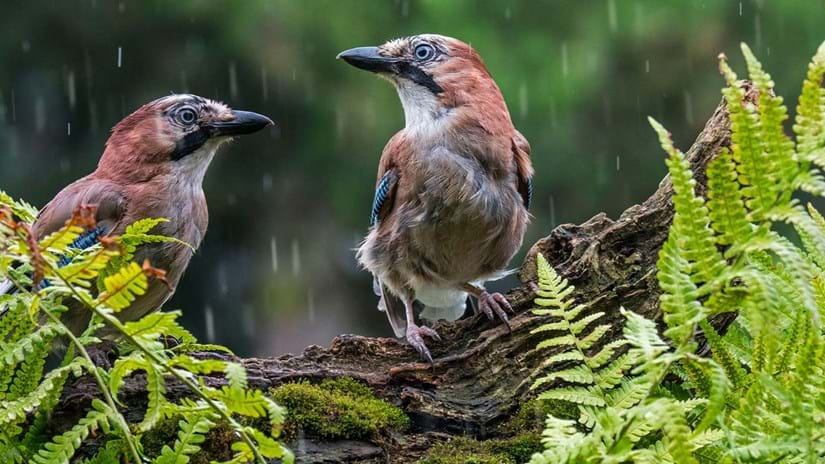
Inside Britain's rainforests
00:03:47
Take a glimpse into Britain's beautiful and fragile temperate rainforests and discover more about the rare and globally important species that live there.
Watch the filmWe acquired Felenrhyd in 1991 and have been restoring it ever since.
We extended the site with Llennyrch with help from the public in 2015.
About Coed Felenrhyd & Llennyrch
History
Coed Felenrhyd & Llennyrch, and other woodlands nearby, are some of the best remaining examples of Atlantic oak woodland in Europe. They are remnants of vast woodlands that once extended from northern Scotland to Portugal.
Early times
During the Iron Age, valleys in the Meirionnydd region were covered in open oak woodlands which slowly changed into scattered birch woodland and heathland. The area was famed for its cattle. Drovers moved livestock eastwards through mountain passes to markets in England using trackways that are still traceable today.
Deep gorges, such as Ceunant Llennyrch, which marks the western boundary of Coed Felenrhyd, were relatively untouched by human activity. They remain ancient woodland where rare species can still be found.
Snowdonia hall-house
While the exact date is uncertain, it is thought that the Snowdonia hall-house that nestles in the heart of the Llennyrch farmland may date back to as early as the 1500s. The property, which was a grand residence in its day, sat in the heart of a mixed farming landscape and acted as a hub of activity. It is likely to have remained in more or less permanent occupation until 2009 when the last residents passed away. Look out for the old, great ash trees surrounding the farm house, some with a girth of 4-5 metres in diameter.

Credit: Phil Formby / WTML
Industry at Coed Felenrhyd
The local timber trade in the area dates back to 1739. At the time, timber was the most important local industry, but by 1760 it was joined by quarrying for slate. Shafts and sink holes in the wood are clues to its industrial past.
The scale of the timber business is reflected in a report from 1763 that sounded a note of concern about deforestation in the Vale of Ffestiniog. It said that Meirionnydd ‘has been much drained of her timber’.
Some 25 years later, the stock of oaks in Meirionnydd and three neighbouring counties were said to be decreased by two-thirds. Advertisements selling timber worth up to £900 appeared in local newspapers.

Credit: Rory Francis / WTML
Farmsteads
As well as Llennyrch itself, a number of small farmsteads, the remains of which are still visible today, were established on pockets of open land. A further farm or small holding is recorded at Ty Newydd, now a ruin standing in a prominent location just south of Llennyrch farm.
Today, old oaks stand where farmsteads once stood, and remains of stone walls mark old field boundaries. Many stone barns, once used for hay or cattle, can still be seen today across the site.
Woodland management
Timber was still in demand during the First World War and it is likely that the early 20th century saw the felling and replanting or coppicing of large areas of oak in the woodland at Llennyrch as there are few ancient trees surviving.
In the late 1960s, huge areas of Coed Felenrhyd were clear-felled and then replanted with fast-growing, non-native conifers. Over time, those conifers came to dominate those areas, blocking sunlight from the forest floor.
Meanwhile, the woodland at Llennyrch was grazed as part of the farm by a 'hefted' flock of sheep. Fortunately, the livestock helped to maintain the open light conditions needed by the rarest lichens and bryophytes in the wood.
Folklore
Coed Felenrhyd is mentioned by name (Melenrhyd, Y Felen Rhyd) in the famous collection of Welsh legends, the Mabinogion, as the last resting place of Pryderi, King of Dyfed, who was killed in single combat with Gwydion the trickster. These tales were written in the 12th century, but the oral tradition is much older.
Walks through Coed Felenrhyd trace some of the adventures of the famous Welsh mercenary and magician – Huw Llwyd. At the height of his fame, people who were plagued with demons would be publicly exorcised by Huw at his famous pulpit – a massive rock in the middle of the River Cynfal – which is still there today.

Keeping Llennyrch wild
00:02:19
Hard graft. Passionate people. Expertise and skill. There's more to our woods than just trees. See for yourself what makes Llennyrch so special, and what it takes to keep it that way.
Watch the film
A lasting legacy
This wood is just one of many to have been protected by gifts in wills, securing it for generations to come. Your legacy gift could also make a real difference to woods, trees and wildlife.
Learn what your gift could meanThings to do at Coed Felenrhyd & Llennyrych
Walking
With a waymarked trail and a variety of enjoyable routes, this wood is popular with walkers. Take in the incredible views and look out for rare and beautiful lichens and mosses. Spot the letter ‘R’ carved into one of the trees – it’s said to be the site of a murder 100 years ago.
Be aware that the routes in this area can be strenuous and steep, and are not suitable for wheelchair users or pushchairs.
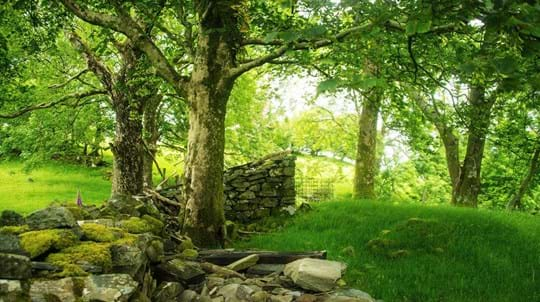
360 tour
Take a virtual tour of Coed Felenrhyd & Llennyrch
Discover for yourself what this slice of Atlantic rainforest has to offer, all from the comfort of your own home.
External link

Visiting woods
Walking dogs in our woods
Dogs are welcome for walkies in our woods. Take a look at our tips and guidelines for ensuring we keep our woods safe and special for dogs and wildlife.

Visiting woods
Events
Discover events at our woods and the festivals and fairs you can find us at soon.

Your support matters
Llennyrch was secured for the future thanks to your response to an urgent appeal. Discover how you helped us bring another incredible place safely under our wing, and what the future holds for this wood.
See what we've achieved



















